The Mona Lisa Does Not Actually Cause the ‘Mona Lisa Effect’
By Kat Long

Do you ever feel like you’re being watched? By a certain Leonardo da Vinci painting, perhaps? Scientists call it the Mona Lisa effect: the sense that the eyes of a figure in a painting or photograph are following you as you move around the room. But according to a new study in the journal i-Perception, the eyes in the Mona Lisa painting don’t actually fit the criteria.
The Mona Lisa effect is real—scholars have documented the phenomenon for nearly 2000 years. The effect doesn’t just depend on the direction of the painted figure’s gaze. The figure’s head position in the painting and the slant of the picture itself create specific geometric conditions in space, distorting the viewer’s perception of the painted person’s stare. The sensation can occur no matter where the viewer is in relation to the portrait.
Until now, according to researchers at Bielefeld University in Germany, no one had tested the effect on the Mona Lisa itself. Gernot Horstmann and Sebastian Loth, members of the university’s Cluster of Excellence Cognitive Interaction Technology, designed a study in which 24 participants viewed 15 different sections of the Mona Lisa painting on a monitor. A simple ruler was placed in front of the monitor, and each viewer marked the spot where they thought the gaze landed on the ruler, which indicated its angle.
An angle of zero meant a straight-at-the-viewer look. A slightly sideward gaze toward the viewer’s ear, corresponding to a 5-degree angle, would still prompt the sense of being watched. "But as the angle increases, you would not have the impression of being looked at,” Horstmann said in a statement.
After analyzing about 2000 assessments from participants, the researchers found that viewers felt the gaze of Leonardo da Vinci’s masterpiece to be at an angle of 15.4 degrees—looking off to their right-hand side, rather than directly at them.
“It is clear that the term Mona Lisa effect is nothing but a misnomer,” Horstmann said. But even though this particular phenomenon has been demystified, people's obsession with the painting will surely continue.